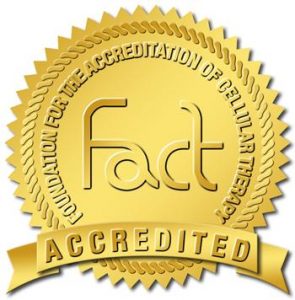 Debe Griffin, MSc, ASQ CPGP, has over 20 years of experience in the cell therapy field, both in bench positions and in leadership. Her primary interests are process improvement, quality assurance and regulatory affairs. She is a consultant with FACT Consulting Services as well as Chimera TQM. She has over a decade of experience as a FACT inspector and auditor.
Debe Griffin, MSc, ASQ CPGP, has over 20 years of experience in the cell therapy field, both in bench positions and in leadership. Her primary interests are process improvement, quality assurance and regulatory affairs. She is a consultant with FACT Consulting Services as well as Chimera TQM. She has over a decade of experience as a FACT inspector and auditor.
In this month’s post, invited guest blogger Debe Griffin discusses the changes to the Foundation for the Accreditation of Cellular Therapy (FACT) Standards, and how they will impact manufacturing facilities developing cell-and-gene therapies (CGTs).
“The Facts around FACT – Part 1” looked at the history of FACT and explained the Standards. Please read that post first, here. Then continue on to learn about the accreditation process and who should apply.
FACT Accreditation
Who is applying for accreditation?
FACT has accredited programs across North America and its global reach includes programs in 23 other countries including Australia, Brazil, Mexico, New Zealand, Turkey and Singapore. There are currently 19 programs in Canada that have obtained FACT accreditation, covering clinical programs for hematopoietic cellular therapy transplant, cord blood banking services, collection facilities and laboratory programs.
Accreditation is public information and a list of all programs can be found here. The corresponding body in Europe, JACIE, jointly develops the FACT-JACIE Standards and conducts an accreditation program in Europe and Western Asia. This ensures there are global standards across blood and marrow transplant programs to provide consistency in guidance for outcomes reporting and review.
While the majority of programs applying for accreditation are integrated Cellular Therapy Programs, there are stand-alone laboratories and collection facilities that have achieved independent accreditation. The types of activities that a facility is accredited for is also public information and can be found in the list of programs above.
What is the accreditation process?
The accreditation process is rigorous. There are baseline criteria for the initial application. The cellular therapy program must perform a minimum number of transplants each year and accredited collection facilities, whether marrow or apheresis, have a minimum number of collections to meet as well. Programs must demonstrate that all facilities are well integrated for the inspection process to be compliant. Policies and SOPs need to be in place for each Standard and submitted to FACT for review. There is a fee for the accreditation process. Once these hurdles have been crossed, the site is ready for an on-site inspection.
When a program is determined to be ready for inspection, a group of volunteer inspectors are assigned. Inspectors are selected based on their qualifications, education and experience. While inspectors are experts in their area, they are still only the “eyes and ears” of FACT. They observe the interactions of the staff, review the submitted documents, confirm actual practice and provide confirmation of the program’s compliance with FACT Standards. A report is submitted to FACT summarizing the inspection team’s observations, outlining the areas where the program is not meeting requirements, areas for improvement, and the evidence of that conclusion.
Who decides if the program is accredited?
The FACT Accreditation Committee makes the final decision to grant accreditation. The volunteer committee is made up of leading members of the cell therapy community, including many of the founders of FACT. They are responsible for reviewing the findings of the inspectors and discussing the observations of the on-site visit. Once the committee comes to a conclusion, the results are conveyed back to the applicant and either accreditation is granted or additional work is needed. Once the program is found to be in compliance, the accreditation is valid for three years.
FACT accreditation provides assurance that a facility has met rigorous standards. This is a patient’s assurance that the cell therapy program is reputable and compliant with activities meant to protect the health and safety of patients.
Sowmya Viswanathan
Latest posts by Sowmya Viswanathan (see all)
- Raman spectroscopy for monitoring therapeutic cell manufacturing – Part 2 - March 28, 2019
- Without new funding, key part of Canada’s stem cell research ecosystem to close - February 28, 2019
- Raman spectroscopy for monitoring therapeutic cell manufacturing – Part 1 - September 6, 2018






Comments